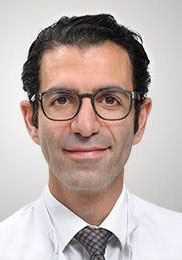Navigation auf uzh.ch
Navigation auf uzh.ch
Surgery is a practical skill, and surgeons are made, not born. To practice their surgical skills on this fall evening, a group of around 10 resident physicians enters the Operating Room X, OR-X. This brand-new surgical research and teaching center at Balgrist University Hospital combines a fully equipped operating room with a surgical training facility, or Skills Lab, that features up to six surgical workstations. This is where the group of medics practices how to insert an artificial knee joint, or prosthesis, as part of a further training course.
After being briefed by the senior physician, the resident physicians make their way to the various workstations. Using real surgical instruments, they go to work and practice attaching the prosthetic knee to the tibia and the femur.
Unlike conventional training courses, which are mostly taught on patients, the OR-X enables surgeons to hone their skills in a highly realistic surgical environment. They gain surgical experience in a safe space, so to speak, without any pressure and without putting an unnecessary burden on their patients – a crucial advantage. “The OR-X gives us a platform for surgical training that provides physicians with a safe environment to advance their practical and surgical skills,” says Mazda Farshad, initiator and founder of the OR-X, medical director of the Balgrist University Hospital and a professor of medicine at UZH.
Since the OR-X went into operation in August, several orthopedic-surgical training courses have taken place every week – both on artificial models and on human specimens. Until now, the OR-X has mainly been used by physicians from the Balgrist hospital. In the future, however, the plan is to open up the training center to UZH students, too. A pilot course that will instruct students in a range of surgical fields is already in the works.

We are investigating simpler and more efficient systems for surgical navigation in the OR-X.
The OR-X is not only a state-of-the-art training facility but also a pioneering center for surgical research. “We can develop new technologies and innovations in a realistic setting,” says Farshad. The basis for this is the center’s high-tech infrastructure, co-financed through UZH’s TRANSFORM funding program (see box).
A number of scientific experiments on computer-assisted surgery are currently underway at the OR-X, including projects exploring how robotics, augmented reality (AR) and artificial intelligence (AI) can provide surgeons with data-based support in the operating room. These novel technologies are rarely used in everyday orthopedic practice, as they are extremely complex and require extensive infrastructure. “To speed up this process, we are investigating simpler and more efficient systems for surgical navigation in the OR-X,” says Farshad.
As part of the FAROS project supported by the EU’s Horizon 2020 program, Mazda Farshad is working together with Philipp Fürnstahl, UZH professor of orthopedic computer sciences, to develop state-of-the-art surgical robotics. The clinician and the researcher are currently developing a multisensory robot for use in spine surgery. Equipped with visual, auditory and haptic sensors, their surgical robot will be able to assist surgeons and carry out certain surgical tasks autonomously (see article).
Fürnstahl is also involved in research on simulator-supported training methods, for example for hip surgeries. As part of a large-scale project dubbed PROFICIENCY, orthopedic surgeons are guided through surgical procedures with the help of AR glasses, which provide them with additional information aimed at making their training more effective and realistic, such as computer-generated images of tissue that help them access the hip bone, or of nerves that they must steer clear of while operating. Their training performance can then be assessed using artificial intelligence.
“Our goal is to develop high-quality training that reduces surgeons’ dependence on instructors, teaches them how to deal with complications, and ultimately helps them avoid making mistakes in practice,” says Fürnstahl.

The OR-X bridges the gap between lab and operating room.
The infrastructure in the OR-X enables scientists engaged in basic research to validate their findings from robotics and AR at an early stage and to develop these step-by-step in collaboration with surgeons. Until now, patient safety concerns and legal requirements have largely prevented researchers from testing new prototypes in a timely and realistic manner. “The OR-X bridges the gap between lab and operating room, and accelerates the translation of research results into everyday surgical practice. This will also benefit patients in the future,” believes Fürnstahl.
For now, novel technologies for computer-assisted surgery will continue to be tested through experiments. They will gradually be combined and integrated into the OR-X. “In the future, a high-performance network will collect data from robotics, AR and imaging systems. An AI that supports surgeons in the operating room will serve as the data-processing interface,” explains Fürnstahl. The ambitious goal is for specific surgeries to be fully digitalized in the OR-X. A first prototype will be available by 2025 (thanks to TRANSFORM). According to Fürnstahl, it should be possible to automatically create full-fledged digital twins of a number of operations by 2027.
By getting clinicians and basic researchers to join forces, the OR-X is pooling the university’s surgical and technical skills under the same roof. “As a platform that combines innovative surgical research and state-of-the-art training methods, the OR-X occupies a unique position in Switzerland,” says Mazda Farshad.
The facility will also be open to other academic institutions and external businesses, in Switzerland and abroad. The OR-X is already being used by some medtech companies to develop and test their products – and the benefit is mutual. “These firms benefit from our proximity to practice, while we researchers gain direct insights into industry approaches and thought processes. Moreover, we can make invaluable contacts, which helps when it comes to implementing our ideas in practice,” concludes Farshad.